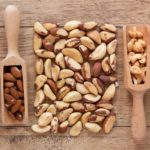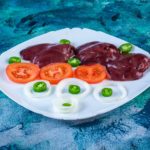
Bernadeth Atrinindarti
MAppSc (Advanced Nutrition Practice)
Note — The article was checked and updated February 2024.
Jump to:
- What is Vitamin B2?
- Vitamin B2 deficiency
- Different types of Vitamin B2
- Health Benefits
- Health Claims
- Best sources of Vitamin B2
- Daily requirements and intake
- How to take Vitamin B2
- Signs and symptoms of deficiency
- Risks and side effects
- Interactions - herbs and supplements
- Interactions - medication
- Summary
- Related Questions
Vitamin B2, or riboflavin is an essential water-soluble vitamin that is important for many processes in the body. An inadequate amount of riboflavin impairs
- Digestion
- Maintenance of macronutrients (carbohydrates, proteins and fats)
- Body energy supply
Vitamin B2 deficiency is not common, but certain groups could be at risk. Also, vitamin B2 is better absorbed from whole foods when compared to supplements.
Therefore, it is important to understand the health benefits of vitamin B2, which foods to eat more, and also to recognize the symptoms of riboflavin deficiency.
What is Vitamin B2?
Vitamin B2, also known as riboflavin, is a water-soluble vitamin that is used by the body to help metabolize carbohydrates, protein and fats.
Riboflavin also functions as an antioxidant to help maintain the immune system and healthy skin and hair.[1]
In 1872, Alexander Wynter Blyth, a British chemist was the first to isolate riboflavin from cow’s milk. He named it “lactochrome” (lacto from milk and chrome due to its yellowish color).[2]
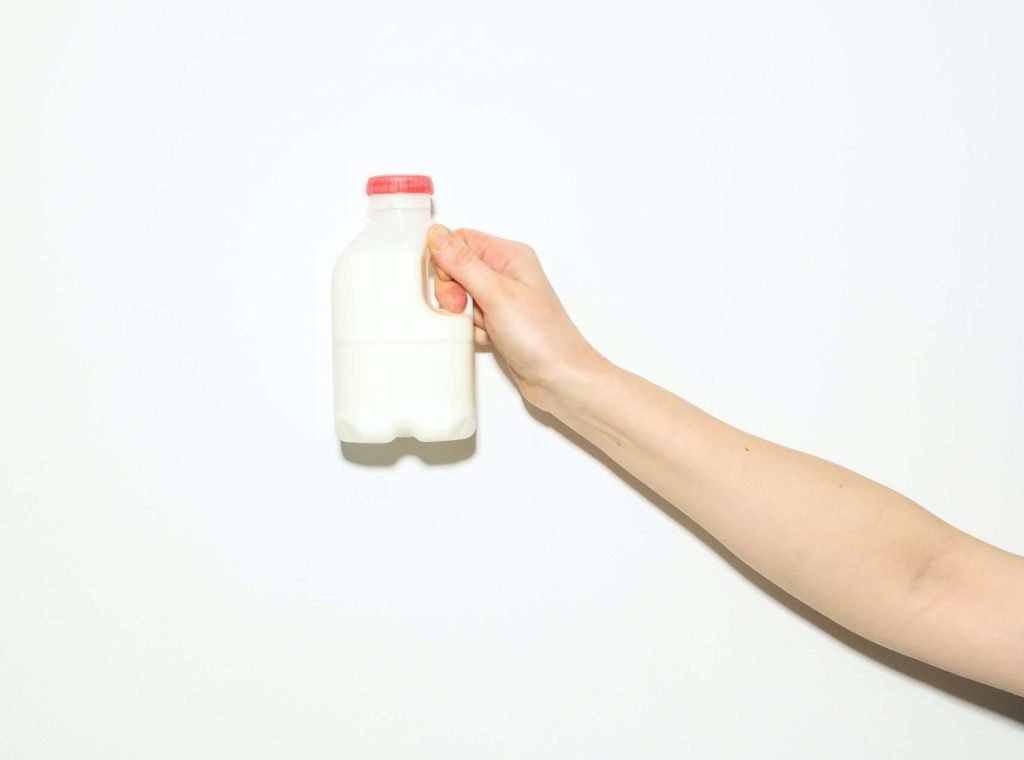
However, Blyth was unable to define the chemical properties of lacto-chrome until 1934 when Paul Karrer, a Swiss chemist, and Richard Johann Kuhn, an Austrian-German biochemist, independently observed and described the structure of riboflavin.[2]
A few years later, in 1939, a study by William Henry Sebrell and Roy Edwin Butler reported that riboflavin is an essential nutrient for human health and was advised that it should be included in the diet.[3]
Vitamin B2 deficiency
An acute deficiency of vitamin B2 is called ariboflavinosis, which rarely occurs by itself and is most often accompanied by other nutrient deficits.
Riboflavin is required in many oxidation-reduction reactions and deficiency may affect many processes in the body.[3]
Vitamin B2 deficiency is usually caused by poor diet or malabsorption
Cases of deficiency mostly occur in low-income or developing countries where the intake of meat and dairy products is low.
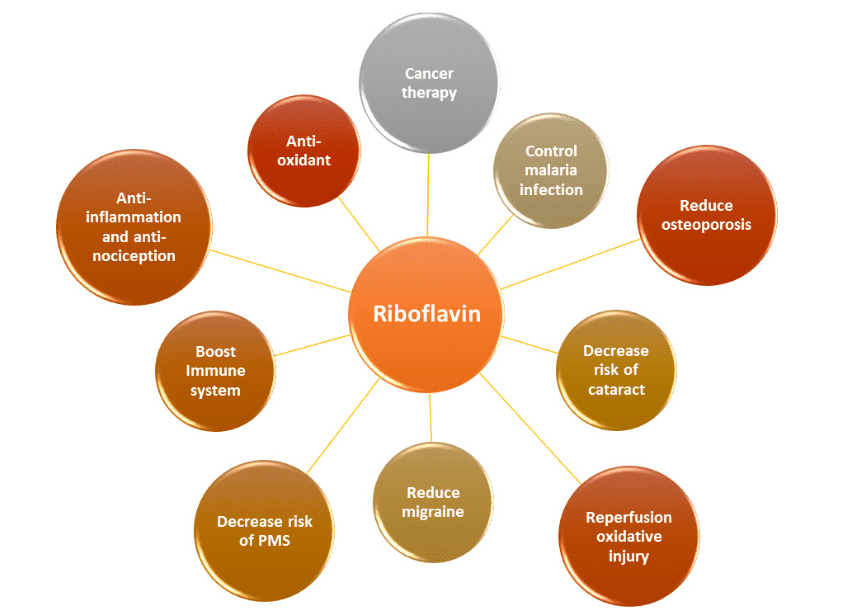
Source: Suwannasom, N. Riboflavin: The Health Benefits of a Forgotten Natural Vitamin. International journal of molecular sciences (2020).
Riboflavin is easily absorbed from food, but oral supplementation of riboflavin alone is poorly absorbed, with only 15% of bioavailability.[4]
Who is most at risk of Vitamin B2 deficiency?
Low vitamin B2 levels in vegans and vegetarians
Vegetarians and vegans are at risk of riboflavin deficiency because of excluding animal products such as dairy and eggs, which tend to be good sources of riboflavin.[5]
A Danish study on vegans reported that 29 out of 70 participants did not reach their recommended amount of riboflavin in their diets. The major food sources of vitamin B2 in Nordic diets are dairy and meat products.[6]
RELATED — The Vegan Diet and Lifestyle: Benefits, Risks and Meal Plans
Elderly people and vitamin B2
A study observed that approximately 60% of elderly people were at risk for riboflavin deficiency. This is because their intake of food and nutrients is lower on average than that of younger adults.[7]
Alcoholic abuse and absorption of vitamin B2
Excessive amounts of alcohol can cause vitamin B2 deficiency because of limited dietary intake and diminished absorption.
A study by Subramanian et al. found that chronic exposure to alcohol reduced the number of riboflavin uptake across the small intestine.[8]
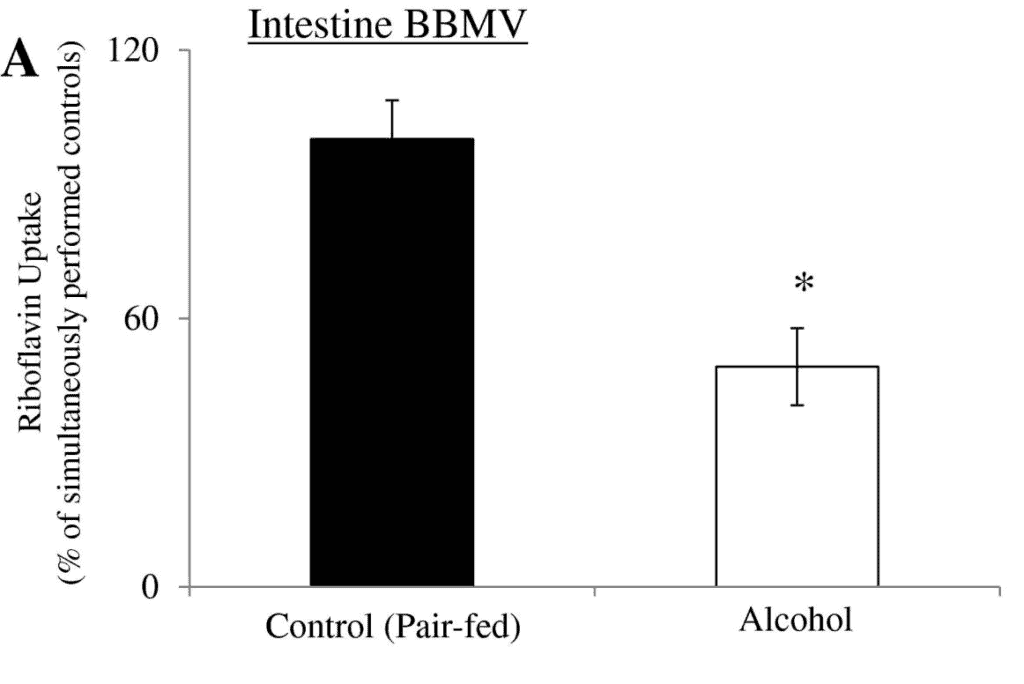
Source: Subramanian, V. S., Subramanya, S. B., Ghosal, A., & Said, H. M. Chronic alcohol feeding inhibits physiological and molecular parameters of intestinal and renal riboflavin transport. (305(5), 2013)
Vitamin B2 in pregnant and lactating women
Pregnant or lactating women who rarely consume dairy and meat products are at risk of riboflavin deficiency, which can affect their health and the health of their infants.
Riboflavin deficiency during pregnancy might lead to preeclampsia
Currently, there is limited evidence on the benefits of riboflavin supplements during pregnancy.[5] In saying that, riboflavin intake during pregnancy had a positive association with infant birth weight and length.
Infants of mothers with riboflavin deficiency or low dietary intakes (<1.2 mg/day) during pregnancy have a higher risk of deficiency and of certain birth defects (e.g., outflow tract defects of the heart).[5]
Different types of Vitamin B2
Vitamin B2 comes in two different forms
- Riboflavin
- Riboflavin-5′-phosphate sodium
Riboflavin
Riboflavin naturally occurs in some foods (e.g., dairy milk, eggs, lean meat) and is fortified in some food products (e.g., cereal or bread).[5]
The dietary riboflavin comes in the form of flavin mononucleotide (FMN; also known as riboflavin-5’-phosphate) and flavin adenine dinucleotide (FAD) which have an important role in the Krebs cycle.
Most of the riboflavin is absorbed nearer to the centre of the small intestine.[5]
Riboflavin-5′-phosphate sodium
Riboflavin-5′-phosphate sodium is an active pharmaceutical ingredient usually used in vitamin B2 supplements or research using vitamin B2.
Riboflavin-5′-phosphate sodium is absorbed by a specific transport mechanism from the upper gastrointestinal tract.[9]
Between these two forms it is better to obtain riboflavin from food sources because it is easier to absorb than those in supplement form. Eating healthy and balanced food could give more advantages than taking supplements and eating poorly.
Health benefits of Vitamin B2
Vitamin B2 and the body’s energy supply
Vitamin B2 is an essential component of two significant coenzymes called FMN and FAD.[5] These coenzymes have a role as a cofactor in the process in mitochondria to convert the energy stored to adenosine triphosphate (ATP) which is the universal energy donor in the cell.[10]
Any disturbance in riboflavin metabolism and absorption may have consequences on the energy supply, which may impair repair and recovery.[11]
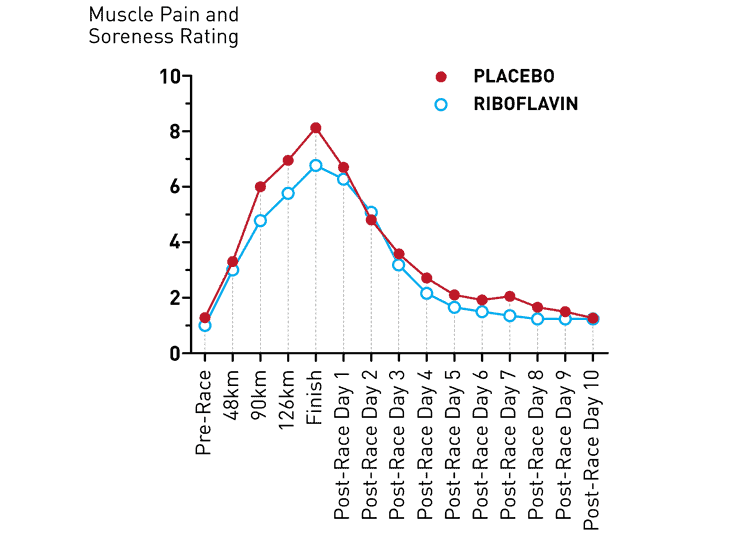
Vitamin B2 and digestion of protein and fats
FMN and FAD, the two flavoprotein coenzymes derived from riboflavin, are also cofactors in the metabolism of essential fatty acids in brain lipids.[12]
A study observed the effect of a diet deficient in riboflavin in rats and after 21-days
- Myelin lipids
- Cerebrosides
- Sphingomyelin
- Phosphatidylethanolamine
which are essential components of the myelin membrane, were decreased.
The myelin membrane is an insulation layer that is made up of protein and fatty substances. This membrane allows electrical impulses to transmit effectively along the nerve cells.
Any disturbance in it would slow down the impulses in the brain.[13]
If you are wondering how food impacts our brain, you might be interested in reading
Role of vitamin B2 in conversion of carbohydrates into ATP
Vitamin B2 or riboflavin is a required ingredient as part of the Krebs cycle, which contributes to the production of adenosine triphosphate (ATP).
In the Krebs cycle, FAD is needed in the process of converting succinate to fumarate.
ATP is responsible for providing energy to many functions in the body, including nerve impulses and muscle contractions.[14]
Vitamin B2 and migraine prophylaxis effect
Several clinical trials resulted in the prophylactic effect of high-dose riboflavin supplementation on migraine attacks.
In an open-label study, a high dose of riboflavin supplementation (400 mg/day) for 6 months led to a reduction in migraine attack frequency.
Another study suggests that riboflavin supplementation (100 mg/day) is equally effective and better tolerated than 80 mg/day of propranolol (a gold standard prophylactic drug) for the reduction of headache frequency, duration, and severity.[3]
Prevention of cataracts and high dose of vitamin B2
A study reported that a high dose of riboflavin (400 mg/day) appears to have a preventive effect on the development of age-related cataracts.
Riboflavin concentration influences the glutathione (GSH) concentration in the lens, protecting the lens against oxidative damage.[4]
Vitamin B2 and autism
The analysis of urinary dicarboxylic acid (abnormal organic acid) is a very important tool used in the diagnosis of several metabolic disorders.
A study observed the level of dicarboxylic acid in the urine of autistic children after supplementation of vitamin B2, vitamin B6 and magnesium.
A daily dose of 20 mg riboflavin orally twice a day for 3 months, reduced the concentrations of dicarboxylic acid in the urine.
Furthermore, the parents of these children reported improvement in some autistic symptoms such as the ability to concentrate and eye contact. However, further study might be needed to investigate this effect.[15]
Health claims that still need more evidence and research
Vitamin B2 and tumor / cancer prevention
A few studies reported mixed results on the relationship between riboflavin intake and lung cancer risk.
A study on
- Current
- Former
- Never smokers
reported a weak inverse association between dietary riboflavin intake and lung cancer risk in the current smokers after the intake of 2.5 mg of riboflavin per day.[16]
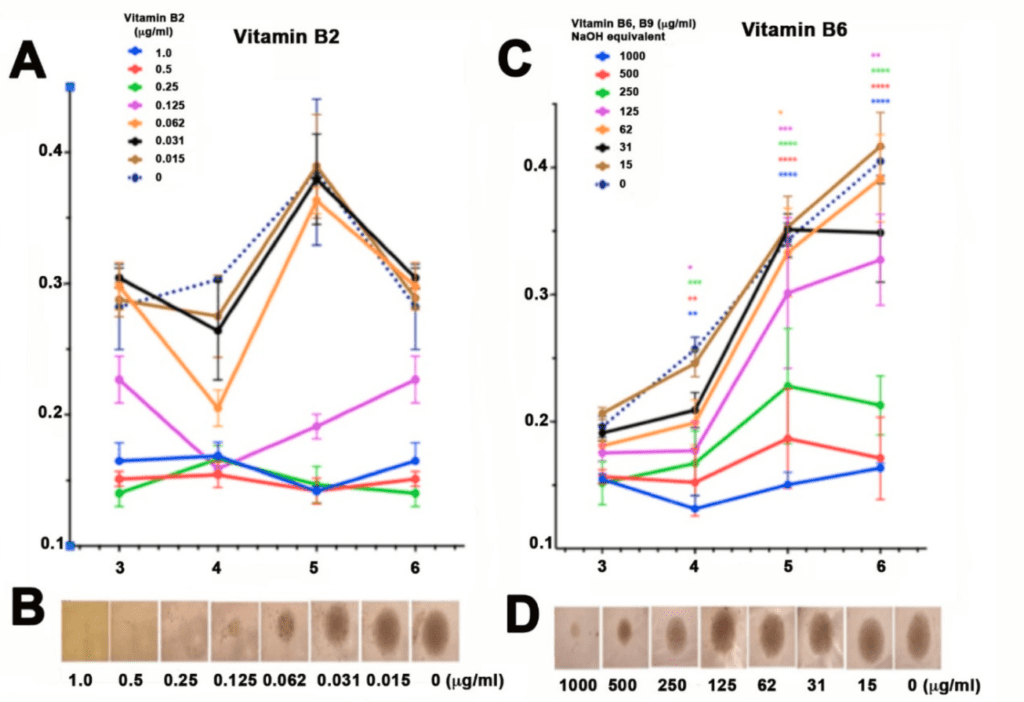
Source: Mikkelsen, K., Anti-Tumor Effects of Vitamin B2, B6 and B9 in Promonocytic Lymphoma Cells. International Journal of Molecular Sciences. (2019)
Another study observed that riboflavin showed a borderline positive interaction with lung cancer risk after an intake of 1.30 mg per day.[17]
Vitamin B2 and Parkinson’s disease
Parkinson’s disease (PD) is a neurodegenerative condition that mainly affects motor function in a chronic and progressive process.
Some evidence suggests that riboflavin may have a neuroprotective role in PD patients.
Low riboflavin levels have been reported in Parkinson’s patients
This study showed that
- supplementation of riboflavin (90 mg/day)
- elimination of red meat from the diet for 6 months
improved motor function.[18]
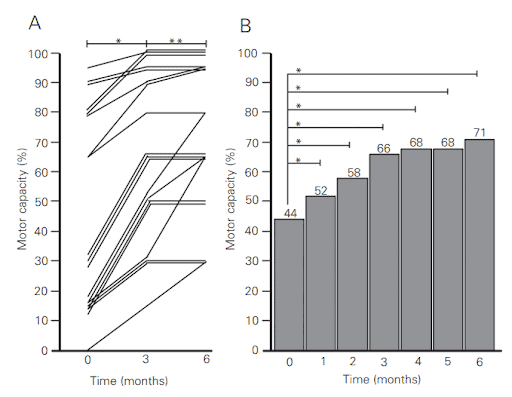
Source: Coimbra, C. G., & Junqueira, V. B. High doses of riboflavin and the elimination of dietary red meat promote the recovery of some motor functions in Parkinson's disease patients. (36(10), 2003)
However, further research comparing riboflavin status between PD patients and healthy control could provide stronger evidence for supporting the neuroprotective effects of riboflavin in Parkinson’s disease.[3]
Best sources of Vitamin B2
Riboflavin is present in high concentrations in
- Nuts
- Meats
- Fatty fish
- Dark-green vegetables
- Eggs
- Mushrooms
- Milk and dairy products
- Legumes[2]
Food Sources | Concentration (mg/100g) | Daily Value (DV) |
Almonds | 1.1mg | 88% |
Beef (skirt steak) | 0.9mg | 66% |
Feta cheese | 0.8mg | 65% |
Eggs | 0.5mg | 39% |
Salmon | 0.5mg | 37% |
Mushrooms | 0.5mg | 36% |
Fortified tofu | 0.4mg | 34% |
Bluefin tuna | 0.3mg | 24% |
Lean pork chops | 0.3mg | 21% |
Spinach | 0.2mg | 18% |
Non-fat yogurt | 0.2mg | 18% |
Soy milk | 0.6mg | 16% |
Lean chicken breast | 0.2mg | 14% |
Whole milk | 0.2mg | 13% |
Avocado | 0.1mg | 10% |
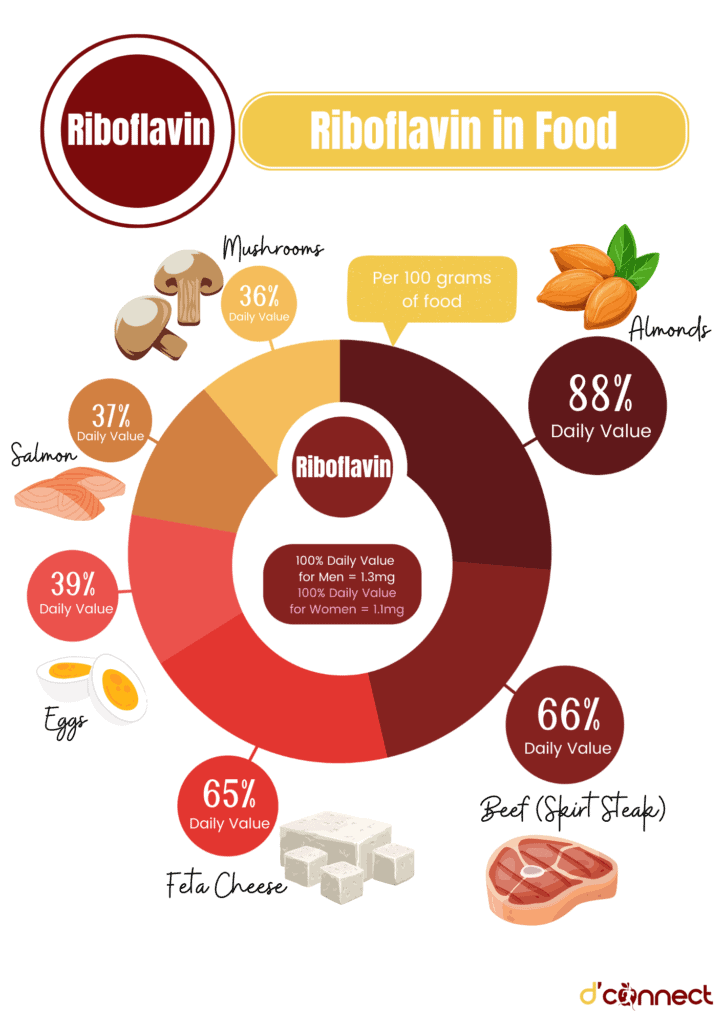
Note — feel free to download and share this illustration.
Daily requirements and recommended intake
A study reported that vitamin B2 deficiency occurs with dietary intakes of less than 0.6 mg/day.
Age | Male | Female |
Birth to 6 months | 0.3mg | 0.3mg |
7-12 months | 0.4mg | 0.4mg |
1-3 years | 0.5mg | 0.5mg |
4-8 years | 0.6mg | 0.6mg |
9-13 years | 0.9mg | 0.9mg |
14-18 years | 1.3mg | 1.0mg |
19-50 years | 1.3mg | 1.1mg |
>51 years | 1.3mg | 1.1mg |
Pregnant and lactating women should add additional 0.3 mg to 0.6 mg of vitamin B2 to their diet or supplementation.[2]
How to take Vitamin B2
It is suggested to consume good-quality and fresh food that make a balanced diet.
Some methods of food processing may alter the content of riboflavin
For example extruding, blanching, milling, fermenting, and sun-drying of fruits and vegetables significantly reduce the amount of riboflavin in food.[2]
Riboflavin can also be destroyed by exposure to light because it’s photosensitive. For example, milk stored in a glass bottle can usually have low quantities of riboflavin.[4]
Also, heating food, microwaving, or exposure to infrared radiation has an effect on reducing the amounts of riboflavin.[2]
Taking vitamin B2 supplements might be beneficial for people who can’t eat a balanced diet every day. It is suggested to take multivitamins between meals.
Common signs and symptoms of Vitamin B2 deficiency
Currently, no diseases related to riboflavin deficiency have been found. However, clinical symptoms of deficiency after 3-4 months of inadequate vitamin B2 intake include:[4]
- Cheilosis and angular stomatitis
Painful lesions or fissures on the outside of the lips and corners of the mouth
- Glossitis
The tongue may appear smooth and magenta in color

- Hyperemia and edema of the oral cavity
- Inflammatory skin condition
Seborrheic dermatitis, which is associated with the secretion of waxy substance found noticeably around the nose or nasolabial fold - Peripheral nerve dysfunction (neuropathy)
- Anemia
Riboflavin contributes to blood cell formation, improves iron absorption and helps in the mobilization of ferritin from tissues. A significant association between riboflavin and iron intake in correspondence to the risk of anemia was detected.
Vitamin B2 risks and side effects
There are no toxicity reports associated with large oral doses of riboflavin. Also, no tolerable toxicity intake level for riboflavin has been determined.
When excess amounts are consumed, the body will excrete them in the urine.
Possible interactions with herbs and supplements
Blond psyllium
Blond psyllium is a herb used as a laxative and stool softener, and it also helps maintain cholesterol levels.
Blond psyllium is available in many different types of products including bread, cereals and snack bars. Blond psyllium may affect the absorption of riboflavin.[19]
Folic acid
Taking folic acid while having a methylenetetrahydrofolate reductase (MTHFR) deficiency, may worsen the riboflavin deficiency.
MTHFR is an enzyme that has a role in amino acid metabolism and is involved in the chemical reaction of folate or vitamin B9.
Folic acid could decrease riboflavin blood levels in people with this condition.[19]
Possible interactions with medications
Anticholinergic medications
Anticholinergic drugs are used to treat a variety of conditions including gastrointestinal spasms, asthma, depression and motion sickness. This type of medication could impair the body to absorb riboflavin.[20]
Tetracycline
Riboflavin interferes with the absorption and effectiveness of this antibiotic.
It is advised to take riboflavin supplements at a different time during the day when taking tetracycline.[20]
Summary
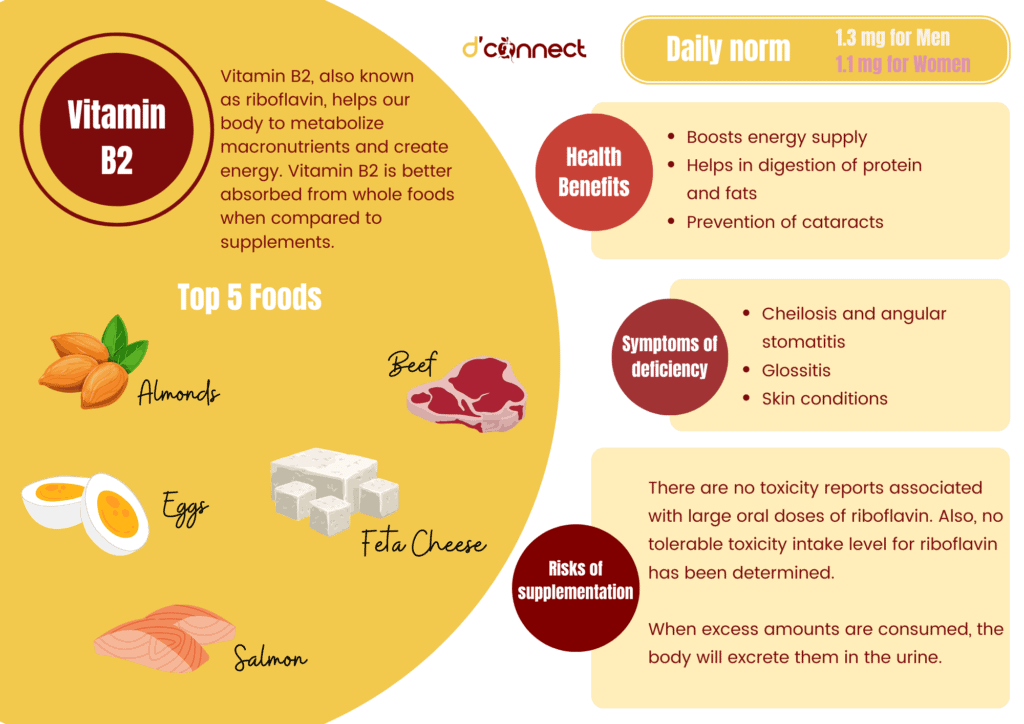
Key Takeaway – In this summary illustration we have outlined the most important information that you should know about Riboflavin (vitamin B2).
Related Questions
1. Which types of milk contain the most Vitamin B2?
Soy milk contains 0.6 mg of riboflavin per 100 g, compared to whole milk with only 0.2 mg of riboflavin per 100 g.
Top 3 milks for riboflavin concentration per 100g:
- Soy milk – 0.6 mg/100g
- Whole milk – 0.2 mg/100g
- Low-fat milk – 0.2 mg/100g
2. What bacteria are used in the production of vitamin B2?
There are three microorganisms currently being used for riboflavin production:
- Ashbya gossypii
- Candida famata
- B. subtilis
In recent years, lactic acid bacteria (LAB) have been proposed for vitamin synthesis. LAB are able to synthesize B-group vitamins, especially riboflavin. It is commonly used in the dairy industry to increase riboflavin concentrations.[21]
3. Does vitamin B2 function as a coenzyme
Yes, it does.
The flavin mononucleotide (FMN – also known as riboflavin-5’-phosphate) and flavin adenine dinucleotide (FAD) play major roles in
- Energy production
- Cellular functions
- Metabolism of fats, protein and carbohydrates
In addition, riboflavin helps the conversion of tryptophan into niacin and conservation of vitamin B6 and B9 into their active forms.
For more articles on vitamins and minerals, and how to get them from whole foods, please see our page Connecting you with Food.
Also, if you missed our previous article in the vitamin B series, you can find it here — Vitamin B1 (Thiamine).
Bernadeth’s passion in cooking, food and health led her to learn more about nutrition and the importance of functional foods. Throughout the years, she gained special interest in sports and performance nutrition, and the varieties of diets around the world. As a nutritionist, Bernadeth’s goal is to encourage a healthy-balanced diet and share the evidence-based nutrition knowledge in order for people to live healthier and longer lives.
Bernadeth is a part of the Content Team that brings you the latest research at D’Connect.
References
(1) Mahabadi N, Bhusal A, Banks SW. (2022). Riboflavin Deficiency. In: StatPearls [Internet]. Treasure Island (FL): StatPearls Publishing; 2022 Jan-. Retrieved from https://www.ncbi.nlm.nih.gov/books/NBK470460/
(2) Plantone, D., Pardini, M. & Rinaldi, G. (2021) Riboflavin in Neurological Diseases: A Narrative Review. Clin Drug Investig 41, 513–527. Retrieved from https://doi.org/10.1007/s40261-021-01038-1
(3) Ahmad Saedisomeolia, Marziyeh Ashoori. (2018). Chapter Two – Riboflavin in Human Health: A Review of Current Evidences. Advances in Food and Nutrition Research 83, 57-81. Retrieved from https://doi.org/10.1016/bs.afnr.2017.11.002.
(4) Suwannasom, N., Kao, I., Pruß, A., Georgieva, R., & Bäumler, H. (2020). Riboflavin: The Health Benefits of a Forgotten Natural Vitamin. International journal of molecular sciences, 21(3), 950. Retrieved from https://doi.org/10.3390/ijms21030950
(5) National Institute of Health. (2022). Riboflavin – Health Professional Fact Sheet [Internet]. Retrieved from https://ods.od.nih.gov/factsheets/Riboflavin-HealthProfessional/
(6) Kristensen, N.B., Madsen, M.L., Hansen, T.H. et al. Intake of macro-and micronutrients in Danish vegans. Nutr J 14, 115 (2015). Retrieved from https://doi.org/10.1186/s12937-015-0103-3
(7) Flynn, A., Moreiras, O., Stehle, P., Fletcher, R. J., Müller, D. J., & Rolland, V. (2003). Vitamins and minerals: a model for a safe addition to foods. European journal of nutrition, 42(2), 118–130. Retrieved from https://doi.org/10.1007/s00394-003-0391-9
(8) Subramanian, V. S., Subramanya, S. B., Ghosal, A., & Said, H. M. (2013). Chronic alcohol feeding inhibits physiological and molecular parameters of intestinal and renal riboflavin transport. American journal of physiology. Cell physiology, 305(5), C539–C546. Retrieved from https://doi.org/10.1152/ajpcell.00089.2013
(9) Gyula Buchholcz, András Kelemen, Tamás Sovány & Klára Pintye-Hódi (2015) Matrix tablets based on a carrageenan with the modified-release of sodium riboflavin 5′-phosphate, Pharmaceutical Development and Technology, 20:6, 676-683, DOI: 10.3109/10837450.2014.910810
(10) Huskisson, E., Maggini, S., & Ruf, M. (2007). The role of vitamins and minerals in energy metabolism and well-being. The Journal of international medical research, 35(3), 277–289. Retrieved from https://doi.org/10.1177/147323000703500301
(11) Udhayabanu, T., Manole, A., Rajeshwari, M., Varalakshmi, P., Houlden, H., & Ashokkumar, B. (2017). Riboflavin Responsive Mitochondrial Dysfunction in Neurodegenerative Diseases. Journal of clinical medicine, 6(5), 52. Retrieved from https://doi.org/10.3390/jcm6050052
(12) Sinigaglia-Coimbra, R., Lopes, A.C., Coimbra, C.G. (2011). Riboflavin Deficiency, Brain Function, and Health. In: Preedy, V., Watson, R., Martin, C. (eds) Handbook of Behavior, Food and Nutrition. Springer, New York, NY. Retrieved from https://doi.org/10.1007/978-0-387-92271-3_153
(13) Ogunleye, A. J., & Odutuga, A. A. (1989). The effect of riboflavin deficiency on cerebrum and cerebellum of developing rat brain. Journal of nutritional science and vitaminology, 35(3), 193–197. Retrieved from https://doi.org/10.3177/jnsv.35.193
(14) Kennedy D. O. (2016). B Vitamins and the Brain: Mechanisms, Dose and Efficacy–A Review. Nutrients, 8(2), 68. Retrieved from https://doi.org/10.3390/nu8020068
(15) Joanna Kałużna-Czaplińska, Ewa Socha, Jacek Rynkowski. (2011). B vitamin supplementation reduces excretion of urinary dicarboxylic acids in autistic children. 31 (7): 497-502. Retrieved from https://doi.org/10.1016/j.nutres.2011.06.002
(16) Bassett, J. K., Hodge, A. M., English, D. R., Baglietto, L., Hopper, J. L., Giles, G. G., & Severi, G. (2012). Dietary intake of B vitamins and methionine and risk of lung cancer. European journal of clinical nutrition, 66(2), 182–187. Retrieved from https://doi.org/10.1038/ejcn.2011.157
(17) Kabat, G. C., Miller, A. B., Jain, M., & Rohan, T. E. (2008). Dietary intake of selected B vitamins in relation to risk of major cancers in women. British journal of cancer, 99(5), 816–821. Retrieved from https://doi.org/10.1038/sj.bjc.6604540
(18) Coimbra, C. G., & Junqueira, V. B. (2003). High doses of riboflavin and the elimination of dietary red meat promote the recovery of some motor functions in Parkinson’s disease patients. Brazilian journal of medical and biological research = Revista brasileira de pesquisas medicas e biologicas, 36(10), 1409–1417. Retrieved from https://doi.org/10.1590/s0100-879×2003001000019
(19) MedlinePlus. Riboflavin [Internet]. (2020). Retrieved from https://medlineplus.gov/druginfo/natural/957.html
(20) Vitamin B2 (Riboflavin) [Internet]. Retrieved from https://www.stlukes-stl.com/health-content/medicine/33/000334.htm
(21) Thakur, K., Tomar, S. K., & De, S. (2016). Lactic acid bacteria as a cell factory for riboflavin production. Microbial biotechnology, 9(4), 441–451. https://doi.org/10.1111/1751-7915.12335



